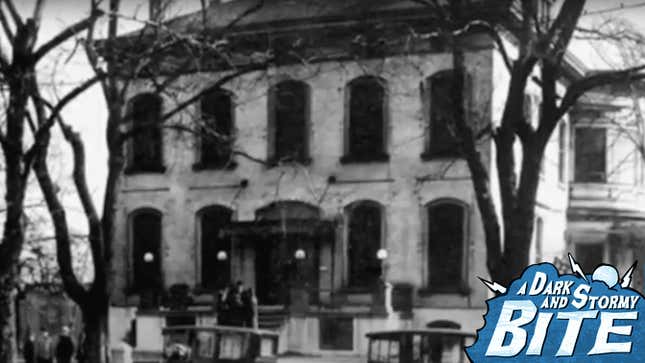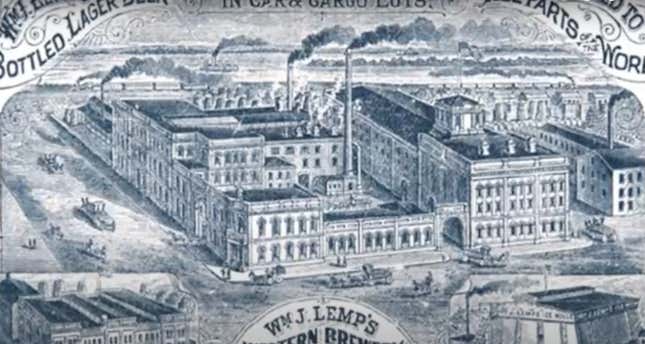
Welcome, foolish mortals, to the home of cadaverous casseroles, exsanguinous eats, and snack-related sagas so strange and frightening they may well transport you to a realm unknown. Welcome, readers, to A Dark and Stormy Bite, a monthly column that dives deep into a teeth-chattering culinary dimension of utterly ghoulish proportions. Basically, if it involves food and goes bump in the night, we’ll cover it here. Do you have a favorite haunted restaurant or cursed recipe? Email lstone@thetakeout.com—and beware.
Gather ’round, my fellow insatiable succubi! Throw back a cold one, ye spectral party animals, for I have a positively bitchin’ yarn that’ll scare your lederhosen clean off. For this month’s column, we’re sucking down a killer lager at the stately Lemp Mansion and the nearby Lemp Brewery, both of which are said to be some of the most haunted spots in North America. Hold onto your steins.
Our journey begins in St. Louis in 1838. That’s when one Johann Adam Lemp arrived from Eschwege, Germany, to seek his fortune as a grocer/brewer. St. Louis Magazine explains that Lemp learned the art of brewing lager from his father back in Germany and used that knowledge to open a St. Louis brewery in 1840. Was he the first German to bring lager to the U.S.? Unclear. While John Wagner is credited with bringing the first lager yeast stateside, Lemp may have smuggled in his own yeast just a few years earlier. Either way, the brewery skyrocketed to success. Lemp passed the operation on to his son William, who succeeded his father as the head of the brewery before spawning eight little beer barons of his own.
By 1870, Lemp was the largest brewery in St. Louis. The Lemp family had secured its place among the Midwestern elite, especially after marrying off their daughter Hilda to Gustav Pabst—yes, of the Milwaukee Pabst family—in 1897. But only a few years later, tragedy struck the house of Lemp. Theirs became a story of untouchable wealth, lavish eccentricity, salacious scandal, disastrous losses, and death after untimely death.
One could argue that the tragic part of the saga kicked off in 1901 when Frederick, William’s favorite son and heir apparent to brewery leadership, died of heart failure at only 28. Three years later, William Sr. shot himself in the head in a bedroom in the family mansion. The family battled scandalous whispers about divorce, violence, and illicit cockfighting until 1919, when Prohibition closed the brewery permanently; shortly after in 1920, William’s glamorous youngest daughter, Elsa, took her own life with a gunshot to the chest.
Things got worse in 1922, when the once-magnificent Lemp brewery was sold at auction to the International Shoe Co. Most of the company’s assets were liquidated, although the Lemps continued to live in the nearby mansion. Shortly after presiding over the sale of the brewery, William Lemp Jr. shot himself. Finally, in 1949, his brother Charles Lemp committed suicide in his bedroom in the mansion after shooting his dog in the basement. Here’s a chilling tidbit: Charles was the only Lemp to leave a suicide note. “In case I am found dead,” he wrote, “blame it on no one but me.”
With so much tragedy tearing through one family, it makes sense that the house and brewery property might have some funky juju. Indeed, paranormal investigators can’t get enough of the place. In this video, historian Betsy Burnett-Belanger insists that the mansion is home to nine identifiable spirits, including one fetid character she calls “the stinky man.” Local paranormal junkies also went semi-viral after sharing a video of an apparition they called “the lady in white.” Lemp Mansion even welcomed the Ghost Adventures team during the show’s ninth season.
Making matters exponentially creepier, the mansion and brewery are connected by a series of underground tunnels and caverns, part of the legendary Caves of St. Louis. The cave system was reportedly the perfect temperature for aging beer, although it also served as a handy way for the Lemps to get to work each morning. Now, it’s home to—you guessed it—a wickedly gauche haunted house. The haunted house is operated by the St. Louis-based company Halloween Productions, with the following warning to potential visitors:
“The all-new Lemp Brewery Haunted House is ready to make you scream. House of Occult located deep underground where NO ONE CAN HEAR YOU SCREAM. Come face to face with demons, confusing mazes, inside a pitch black cavern of the occult. Lemp Brewery is the most famous haunted place in American [sic] prepare to go into the abyss to scream.”
Yes, readers, someone has taken this very old, very stately property and transformed it with “state of the art animations, sets, props, sound effects and special effects,” highlighting the brewery’s “old rusty pipes and worn down machines from a time long ago.” There’s nothing creepier than worn-down brewing equipment, I guess. The 20,000-square-foot attraction also features “tens of thousands of dollars [worth of] monsters, dead zombie gangsters, a massive animated alligator, creepy rats, bats, and long lost brewery workers of the dead.”

If you’re put off by the idea of dead zombie gangsters and a massive animated alligator, you can take the slightly classier approach and tour the mansion with the help of Betsy Burnett-Belanger, the aforementioned historian and paranormal expert. For the low, low price of 25 bucks (plus tax and handling fees), you can get yourself a tour that concludes with a “dark room session” during which Burnett-Belanger will “attempt to make psychic communication.”
And there you have it: an American story in three parts. Immigrant family achieves awe-inspiring beer fame; immigrant family suffers half a century of tragic losses fueled by vicious speculation and a hefty dose of untreated mental illness; Midwestern charlatans capitalize off said tragedy and install a massive animated alligator on the property. Today, the real ghoul appears to be... capitalism. It’d be great if I could turn into a bat and fly away after making that statement, but I’m writing this from my couch. Also, this is the internet, which means you can’t see me. Picture me turning into a bat, okay? Boom. Bat.